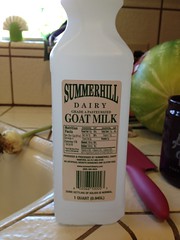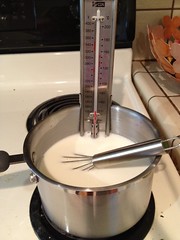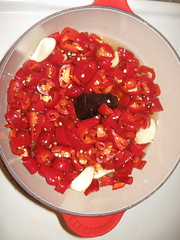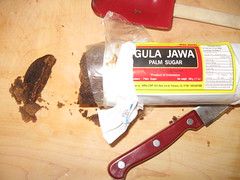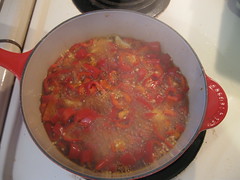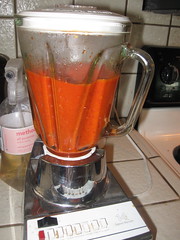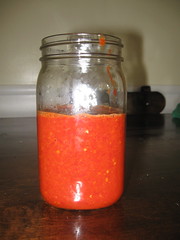Resources
Ball Canning Book: If you get one book, get this one. It has all the basics with clear, easy instructions.
foodinjars.com This web site has hundreds of recipes for things like jam and pickles, as well as for ways to use them. She has sort of a focus on small batches, so if you wanted to throw together four pints before bed, this is your web site.
pickyourown.org This web site is just horribly designed. But if there’s a fruit you’d like to can, or something you want to pickle or turn into jam, this site probably has a recipe. Very informative.
My friend Analisa added:
The National Center for Home Food Preservation is hosted by University of Georgia. They're the folks who make and change the rules. The list of recipes is comprehensive and completely safe. They also have the only canning safe recipe for lemon curd and it's great.
Master Food Preservers: like master gardeners except for canning. They have a bunch of great one page food safety type hand outs.
Mrs Wages is a company making canning products and seasonings. Mrs. Wages is to canning what Betty Crocker is to cakes. All of their recipes are going to call for their seasoning mixes, etc. that said, the recipes and products are safe and reliable. My Aunt and my cousins love it. To me it defeats the reasons I can. http://www.mrswages.com
Canning Across America has more modern recipes and an impressive list of contributors.
The complete book of home preserving by ball is much more comprehensive than the blue book. It's the joy of cooking for canning. If you want a basic recipe its in there.
I love the Put 'Em Up books by Sherri Brooks Vinton. In addition to canning recipes that are very modern in flavor combinations she includes recipes for using the canned goods.
Saving The Season by Kevin West is a touch pedantic and I don't care for his writing style but the recipes are generally good and unique enough that I keep it around.
Canning for a New Generation by Liana Krissoff is good.
The blue chair jam by Rachel Saunders came out to wide critical acclaim years ago. It was quickly criticized by food safety experts because she advocates oven canning. The flavor combinations and profiles are interesting but I don't use it as a reference.
Kara’s tips and tricks:
If you have time to chop fruit, but maybe not time to make jam, you can always macerate it with the sugar in a Ziplock gallon bag in the fridge. It will keep for about a week. You can also add additional flavorings while it macerates.
If you prefer less sweet (or diabetic-friendly or honey-flavored or whatever) jams, try ordering Pomona’s Pectin. Pay careful attention to the directions, because you have to mix the pectin powder with the sugar or sugar substitute first, and boil the jam with a bit of calcium water before adding the sugar, but since I strongly prefer less-sweet jams, it’s a lifesaver. Low-sugar jams are better enjoyed in the first 6 months, rather than the whole year (the color changes, although they don’t become unsafe).
If you prefer less sweet (or diabetic-friendly or honey-flavored or whatever) jams, try ordering Pomona’s Pectin. Pay careful attention to the directions, because you have to mix the pectin powder with the sugar or sugar substitute first, and boil the jam with a bit of calcium water before adding the sugar, but since I strongly prefer less-sweet jams, it’s a lifesaver. Low-sugar jams are better enjoyed in the first 6 months, rather than the whole year (the color changes, although they don’t become unsafe).
Some flavors I’ve had a lot of fun playing with include chiles, lavender, vanilla, star anise, lemon verbena, black pepper, cardamom… You do have to worry about the Ph of your jam, but a very small amount of an herb or spice is not likely to change it, so feel free to experiment. You may also have good luck with extracts and liquors. I made, for example, a plum-Madeira jam recently.
Store jars with the rings off. Also, it’s helpful to label your jars with the date, because they’re best used within a year. Before putting them away, pick each jar up off the counter using just the lid. This will tell you if you have a good seal.
You can totally make jam with frozen fruit. Trader Joe’s has frozen berries for cheap that are great for this purpose.
The process for making pickles is very like the jam process. Feel free to experiment with those, too. We’ve had great luck with spicy pickled carrots and beets.
On safety
If you stick to high acid fruits and pickles the chances of you getting or giving someone botulism is nil. All reported cases of botulism from home canning come from improperly processed meat and low acid veg.
Use wooden, plastic or rubber spoons and spatulas, not metal, as metal can chip or weaken the glass.
Always check your jars for chips and cracks, especially around the rim.
Use lids only once (the sealing stuff gets used up), but rings can be reused endlessly.
The USDA says only bottled lemon juice is acceptable for canning, but as long as you aren’t using Meyer lemons, lemon juice from the fruit is probably fine.
Leaving headspace (a bit of air at the top of the jar) is important. Most jams/jellies will call for 1/4 inch. It helps to create the vacuum seal. You can measure 1/4” easily using the stair-steppy air bubble tool that comes with most canning kits. One stair is 1/4”!
Use lids only once (the sealing stuff gets used up), but rings can be reused endlessly.
Some surprisingly good recipes!
Pickled cranberries: amazeballs on a sandwich, the pickling brine is great mixed with soda water as a tart drink, and these are lovely in several kinds of cocktails as well.
Tomato jam: at first, you go, “tomato jam? Sounds weird.” Then you put some onto good bread with a hunk of sharp cheddar and you go “where have you been all my life, tomato jam?”
Last minute dessert made with a bit of jam. You may have the ingredients on hand.
PEAR-GINGER CONSERVE
Time: 30 minutes preparation; 50 minutes cooking; 15 minutes processing.
4 Lbs. ripe pears, peeled and chopped (about 9 C)
3 C. sugar
½ C. lemon juice
4 tsp. grated lemon zest (no white pith)
¼ C minced crystallized (or candied) ginger
1 cinnamon stick
Prepare 6 half-pint canning jars (run them through the dishwasher and leave them in the hot machine, or wash the jars in hot soapy water, rinse, and hold in hot clear water)
Time: 30 minutes preparation; 50 minutes cooking; 15 minutes processing.
Combine pears with remaining ingredients in large saucepot. Cook, stirring frequently, until sugar dissolves. Cook rapidly until thick, stirring to prevent sticking, about 30 minutes. Mixture will mound up on spoon. Remove cinnamon stick.
Pour into prepared jars, seal, and process:
* Fill jars with hot mixture, leaving ¼ inch headspace between the top of food and lid
* Run a wooden spoon around the jar between the food and the glass to release any trapped air bubbles.
* Wipe the rim clean. Place lid on jar and screw bands securely, but don’t use force.
* Place the jars in a large stockpot or canning pot, leaving enough space between jars for water to circulate.
* Add boiling water to cover jars by 2”. Return to a full boil.
* Cover pot and process for fifteen minutes.
* Carefully remove jars with tongs or jar lifter and allow to cool.
Many thanks to my friend Analisa, who helped me put this together.
